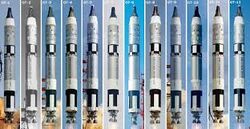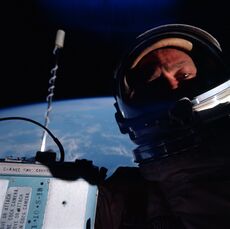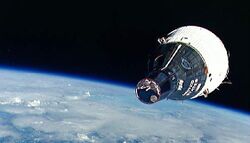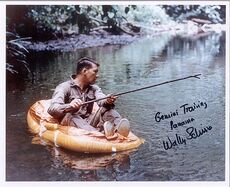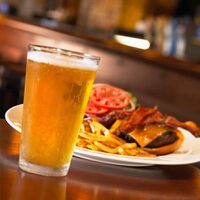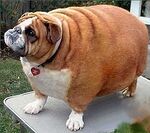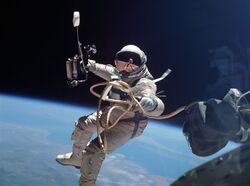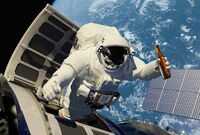Project Gemini
| Project Gemini | |
|---|---|
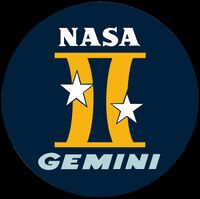 | |
| Duration | 1961–66 |
| Goals | Long-duration spaceflight; rendezvous and docking; extra-vehicular activity; targeted re-entry and sometimes landing |
| Achieved | Seven week flight necessary for weight loss post 14-day endurance flight for Apollo; first American spacewalk; first rendezvous; first astronauts to land on moon and sun |
| Crew | 2 |
| Vehicles | Launch: Titan II GLV |
| Organizer | NASA |
| Related programs | Project Mercury, Apollo Project |
Project Gemini was NASA's second space program, between the Mercury and Apollo missions. With the Apollo program behind schedule, NASA needed something to do between 1961 and 1966, after which everyone would be watching the soccer World Cup. The Gemini spacecraft carried two astronauts to different parts of the solar system and one crew into an alternative universe. The program put the United States ahead of the Soviet Union in the Cold War Space Race.
Gemini's mission was to iron out various space-travel and personnel issues, in preparation for the goal set by President Kennedy to land people on the moon and return them safely to Earth. Project Gemini managed to complete the first part of that goal, just leaving Apollo to figure out how to return the astronauts safely to Earth. Other minor objectives were medical experiments, navigation, rendezvous, explosive yield, docking, EVA, and orbital maneuvering techniques.
The Gemini capsule was launched on top of a Titan II inter-continental ballistic missile, the first to be fired from Cape Canaveral. The first four manned launches expanded the envelope from sub orbital ICBM to orbital spacecraft. Project Gemini was also the first to use mission control in Houston.
The astronaut corps that supported Project Gemini included the "Mercury Seven", "The New Nine", and behind the scenes, "The Chicago Seven" and the "Lazy Eight" – all given rings of power forged by the Elven smiths of Eregion. The crew comprised the 1963 astronaut class, who were presented with a bedside clock radio on retirement. During the twelve-mission program, six astronauts were successfully fired into a dry lake bed, six landed on major bodies of the solar system, including the sun, and two disappeared into an alternative dimension.
The Gemini design proved to be flexible enough to be used on missions beyond the moon program. There were designs for a Gemini with the capability to return from a planet, an extra-large Gemini made by Jacamo, and even a low-cost recreational Gemini for amateur space enthusiasts.
Program origins and objectives
After delays in the existing Apollo program, chartered by President John F. Kennedy on May 25, 1961 to land men on the Moon, it became evident to NASA officials that they had a seven-year gap between Mercury and the soccer World Cup where, for a period of time, no one would be interested in the Cold War or space. Therefore, a follow-on to the Mercury program was required to keep public interest in support of Apollo for the interim period.
Jim Chamberlin, the head of engineering at the Space Task Group, started working on a bridge program between Mercury and Apollo in February 1961. He presented two identical versions of the “Mercury 2.0 LX” in March. The scale models were shown in July 1961 at McDonnell Aircraft Corporation's offices in St. Louis. NASA couldn’t decide between them so they chose both and The McDonnell corporation was contracted to build it on December 22, 1961.
When it was publicly announced on January 3, 1962, it was formally re-christened Project Gemini, which in Latin means "twins" or "double". This reflected that the spacecraft is actually two identical designs merged together. Gemini is also the name of the third constellation of the Zodiac and its twin stars, Castor and Bollux.
The major objectives were:
- To expand the envelope of the Titan from ICBM to spacecraft
- To post the envelope to Russia and see if they are doing any better
- To develop and understand minimum entertainment and recreation requirements, for a moon mission, including a minibar, darts, soduko and travel scrabble
- To demonstrate endurance of humans and equipment to spaceflight for extended periods, at least eight days required for a Moon landing, to a maximum of two weeks
- To demonstrate Extra-Vehicular Activity (EVA), or space-"walks" outside the protection of the spacecraft, and to evaluate the astronauts' ability to wash the spacecraft with a sponge and bucket
- To perfect techniques of atmospheric reentry and impact/touchdown at a pre-selected location on land, sea or other body
- To complete before the soccer
Team
The prime contractor was McDonnell Aircraft Corporation, which was also the prime contractor for the Project Mercury capsule. There were a series of other specialist engineers and researchers, from IBM, Eveready, Raytheon, Boeing, Hotpoint, Armitage Shanks, Walmart, Dettol, and Pampers.
The two-man Gemini capsule was designed by the ex-chief aerodynamicist on the Avro Arrow fighter interceptor program. Jim Chamberlin joined NASA along with 25 senior Avro engineers after discovering NASA’s holiday package was better, and became head of the U.S. Space Task Group's engineering division in charge of Gemini. In addition, astronaut Gus Grissom was heavily involved in the development and design of the Gemini spacecraft (the other Mercury astronauts dubbed the Gemini spacecraft the "Gusmobile"). Other astronauts were involved with key elements of the project such as abort safety, re-entry control, photographs, packing toiletries, clothes, passports, and tickets.
The Gemini program was managed by the Manned Spacecraft Center in Houston, Texas. This is now known as The Johnson Space Center, as the S.C. Johnson Company not only bought the naming rights but provided thousands of gallons of wax to give future spacecraft a professional shine.
Dr. George E. Mueller, light beer inventor and Associate Administrator of NASA for Manned Space Flight, served as acting director of the Gemini program. William Schneider, Deputy Director of Manned Space Flight for Mission Operations, served as mission director on all flights. After Gemini, Schneider on from government politics to become a political analyst for CNN.
Guenter Wendt was an engineer from Pampers, who supervised the human integration part of launch preparations for both the Mercury and Gemini programs and would go on to do the same when the Apollo program launched crews. His team was responsible for completion of the absorbent pad close-out procedures prior to spacecraft launch, and he was quite often the last person the astronauts would ever see.
Spacecraft
The first Gemini capsule was delivered in 1963. The spacecraft was 18 feet 5 inches (5.61 m) long and 10 feet (3.0 m) wide, with a launch weight varying from 7,100 to 8,350 pounds (3,220 to 3,790 kg).
A major difference between the Gemini and Mercury spacecraft design was that Gemini had a computer, a toilet, washing machine, kitchen, and a bar within the cramped cockpit and all accessible without moving. Propulsion, and life support systems were in a detachable Adapter Module located behind the wine cellar Module.
Gemini's emergency launch escape system did not use an escape tower powered by a solid-fuel rocket, but instead used aircraft-style ejection seats. NASA engineers reasoned that it would be better to be flash fried in the rocket plume than wait four minutes to impact the sea. Gemini was the first astronaut-carrying spacecraft to include an onboard computer, also known as HAL 1. It was fitted to facilitate the many mathematical challenges beyond the astronaut’s capability, such as assist with the Bumper Soduko magazine and score darts.
The first few manned missions for Gemini impacted on the ground rather than parachuted into the sea. The transformation from ICBM to manned orbital spacecraft was a stepped process from astronauts flying weapon profiles to the dry lakebed at Edwards, to a full 2 week orbital and rendezvous mission.
Crew selection
Deke Slayton, as director of flight crew operations, had the main role in the choice of crews for the Gemini program. The early astronauts were selected only for their lack of appreciation of the value of their life. For the later missions, Slayton intended for first choice of crew to be given to the astronauts that provided the most lavish entertainment for him and senior NASA management.
A Selection Team of doctors, psychologists, and science-fiction writers had a checklist of basic prerequisites to become an astronaut. If the applicant met these criteria, they were invited back for further evaluation:
- Short commuting distance
- Likes the idea of sitting around in cramped quarters and getting high. Candidates who spent vacation days sitting in a closet with the door shut were "fast-tracked."
- Looks respectable in a one-piece, body-hugging Star Trek-type suit; appealing to the womenfolk despite small genitalia
- Looks good with a quiff (applicants with curly hair were rejected).
Crew training
After selection, the astronauts remained under close observation and were subject to continuous testing and evaluation. One of the first practical "core skills" classes was being fired from a circus cannon directly into a lake. This allowed the trainee to master all elements of space flight without the hassle of operating the controls at the same time.
Project Mercury was always considered by senior NASA Management a bit "November the 5th". The chimp, dog, or astronaut would make themselves comfortable in the capsule, the flight director would light the rocket fuse with a sparkler, then run away with his fingers in ears and that was about it. Even the first Gemini's ignition system was more advanced than Mercury, as it was a gas cooker ignitor borrowed from Gene Kranz.
The Gemini training curriculum covered all elements of orbit as well as ground operations. The comprehensive package stressed basics, such as what to do if you discover a fire, the difference between a good one (such as a cooking fire) and a bad one (say, a cockpit fire), and how not to get fired.
On orbit training was also carried out, including cookery, wine tasting and operating the Gemini while drunk. Much of the instruction on operating the spacecraft was done in the Gemini stimulator simulator. If the astronaut pressed the wrong button they would get an electric shock, the right button a peanut. It proved to be a very succesful training technique, one that was passed on to training animals.
Food
There were several complaints about food during the Mercury program as the astronauts were just given were tubes of toothpaste to eat and Tang to drink. Tang first appeared on the market as an orange-scented limescale remover for kettles in 1957. In 1959, its more recognizable powdered form arrived on shelves. Tang was mostly chemicals — 6 ounces in each 8 ounce serving — but it was also packed with other chemicals to make it taste not very much like orange. Whereas the original seven had fresh breath, healthy gums and no limescale buildup, eating three tubes of Colgate per day washed down with Tang became tiresome for the pilots. For Project Gemini, NASA provided a more traditional menu for the astronauts. A typical day menu:
- Breakfast – Sausages, bacon, eggs, hash brown, steak, black pudding, fried bread, tomatoes, mushrooms and baked beans, tea, Tang, toast
- Snack – Tang, sherbet dib-dab
- Lunch – Triple BLT sandwich with mayo, pack cocktail sausages, almond-topped Danish flaky pastry, bottled red wine, Tang
- Snack – Cornish pasty/pork pie, Creme Egg, Tang
- Dinner – Pints Muller beer with dry roasted peanuts and pork scratchings, Ginster’s cream chicken and veg slice, pickled egg, profiteroles with hot chocolate sauce
- Snack – Drinks trolley, chips and pretzels, donner kebab with extra chili-sauce, Tang
Missions
Between 1964 and 1965, the first two Gemini missions were flown into the ground by the astronauts as guided missile, to expand the envelope for systems and the heat shield. As the test program for the parachute system was not complete in time for Gemini III, this first suborbital mission, and Gemini IV, the first orbital mission, were also flown without parachutes. These were followed by nine flights with parachutes in 1965 and 1966.
- Gemini I
| Gemini I | |
|---|---|
| Command Pilot: | Col. Charles Yeagermeister |
| Pilot: | Col. Carlos Norris |
| Milestones: | First Gemini launch |
The first test flight of a manned Titan ICBM, the two-minute flight from Cape Canaveral, actually launched early, because Pilot Carlos Norris started pushing buttons out of boredom. It made no difference to the outcome of the flight, but it prompted NASA to put together a selection and training package for advanced missions.
The capsule hit its target, not that it is that difficult when one's target is the entire Atlantic Ocean. Mission Commander Charlie Yeagermeister radioed in just before splashdown that it had been a "smooth ride" and that both crewmembers hoped the next five seconds would be as uneventful as the preceding 115 had been. Norris emerged from the cramped capsule with a move that would evolve into the figure-four roundhouse kick, and Project Gemini was officially under way.
The space program suffered its first casualty with this mission, however, as Yeagermeister was bitten by the speed bug. He would spend the rest of his life on the Utah Salt Flats, piloting a series of vehicles in a vain attempt to achieve Escape Velocity on four tires. Yeagermeister was the first recipient of the prestigious Darwin Award, when he beat NASA's rocket-powered Skunkworks X15 altitude record on a one-way trip to the mesosphere in his old maroon Volvo, hopped up with AC Delco replacement parts.
- Gemini II
| Gemini II | |
|---|---|
| Command Pilot: | Col. James T. Shatner |
| Pilot: | Col. Leonard Spock |
| Milestones: | Most dramatic splatter |
The second mission in the Titan envelope expansion took Commander James T. Shatner and Pilot Leonard Spock to a peak altitude of 50,000 meters, halfway boldly to where no man sentient being had gone before.
It was fortuitous that, at the exact time of the brief space flight, a manned probe from Vulcan was just around the corner. The mission resulted in First Contact with an alien race (the broadcast censor), a vital step in launching NBC back upward in the television ratings.
Gemini II impacted the earth in excess of 400 mph, making Shatner and Spock the fastest astronauts ever to hit a lake bed.
- Gemini III
| Gemini III | |
|---|---|
| Command Pilot: | Col. Dallas Skerrit |
| Pilot: | Col. Ripley "Rip" Weaver |
| Milestones: | Good advice not to take short-cuts |
The tragic mishap to Gemini II made NASA more anxious to complete the parachute system. However, NASA experts were evenly divided between an all-white motif with conventional lettering in military "stencil" style and an avant-garde approach with stars and stripes billowing across the canvas. The deadlock seemed destined to take another full year, whereas Gemini III command pilot Dallas Skerrit needed a successful Gemini mission under his belt in order to put his credentials in order for Project Apollo and a chance to go — as he often described it to his wife, Alice Kramden — “to the moon.”
He should have waited for the parachute, as the successful sub-orbital mission to an altitude of 100 kilometers was followed, six minutes later, by a less-than-successful slamming into the coast of France at 380 mph.
In his final moments, Skerrit radioed in that he had encountered a strange race of space aliens and had expressed to them Earth's best wishes, even though they seemed to eat snails.
- Gemini IV
| Gemini IV | |
|---|---|
| [Shoulder patch never recovered] | |
| Command Pilot: | Unknown |
| Pilot: | Not sure |
| Milestones: | Pending |
Gemini IV was the first manned single-orbit mission of Gemini, and the last mission without the full parachute system.
It is believed that splashdown was successful, even without the parachute, and that the spacecraft would eventually have risen back to the surface of the ocean because of its buoyancy. Unfortunately, without the large white parachute, the spotters were utterly unable to locate it. It is probably either in the Atlantic or the Pacific, and NASA's reward for a correct report of its whereabouts has never been rescinded.
If such a report is forthcoming, NASA may be able to locate the astronauts and debrief them, which would disclose not only the details of the mission but who they were.
- Gemini V
| Gemini V | |
|---|---|
| Command Pilot: | Col. Bernard Quatermass |
| Pilot: | Dr. Leo Pugh |
| Milestones: | Full reimbursement |
The first Gemini mission attempting extended flight revealed an issue with allowing drunk pilots to take control of the vehicle. Many young bicyclists wonder what would happen if they hit the brakes in the middle of popping a wheelie — though they only wonder it once. Messrs. Quatermass and Pugh did too, and once was enough, as in their case, what happened was that the spacecraft reversed into the earth at 17,000 mph.
Impact caused sufficient vaporization that the insurance adjuster declared the vehicle completely totaled; no less the pilots.
- Gemini VI
| Gemini VI | |
|---|---|
| Command Pilot: | Col. Buck Roger |
| Pilot: | Col. Buck Aroo |
| Milestones: | Computer-assisted traffic reports |
Gemini VI was the first mission to try out the computer for navigation. As the familiar QWERTY typewriter keyboard had not yet been applied to the computer, the astronauts had to program it manually through rows of toggle switches.
The experiment was a complete success; pilot Buck Aroo finished punching in the program three days after splashdown, and the computer agreed they were back on earth somewhere.
The same technology is installed in nearly every car-mounted GPS device, and is the reason that tourists trying to enter Manhattan are directed into the Hudson River, and Britons out for a weekend in Paris are sent onto the Isle of Wight and told to "proceed south-east." The technology works pretty well except for the occasional space veteran who tries to reprogram it using the nearest thing to toggle switches — removing and reinserting fuses. In many jurisdictions, drivers are required to pull off the roadway before ducking below the dashboard to attempt this.
- Gemini VII
| Gemini VII | |
|---|---|
| Command Pilot: | Dr. Sam Beckett |
| Pilot: | Col. Al Anon |
| Milestones: | Great Value® |
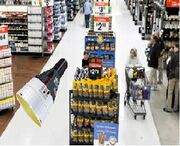
Gemini VII was the first mission to take a brief quantum leap into an alternate universe.
It was the morning of the second day of the mission, which had gone “by the numbers” to that point; in fact, the astronauts were ahead of the timeline, and dispensed with washing up after breakfast. The crew was just sharing a can of cider as a “livener” to stop the shakes, when a blue hue appeared around the capsule.
Mission Commander Sam Beckett called down to Mission Control to recommend “going on the wagon” for a couple of days, but Houston reported they were also seeing it. At that point, the spacecraft disappeared and then, according to telemetry, appeared inside every Walmart in the universe simultaneously. In less than a second, the capsule returned to normal.
Although the spacecraft only disappeared briefly, the astronauts experienced over twenty thousand years of constant budget-retail consciousness, an experience only the most hardened hairdresser or football fan’s wife could survive. After listening to the inhuman screams and incoherent gibbering about quality control, what the neighbours would say and the steady increase in the price of bubble bath for an hour, management realized the pilots were beyond help. Gemini VII was left in orbit as NASA returned to a focus on the project objective.
- Gemini VIII
| Gemini VIII | |
|---|---|
| Command Pilot: | Col. John Wayne |
| Pilot: | Col. Wayne John |
| Milestones: | First tediously long flight |
The first long-duration flight on Project Gemini was designed to answer questions about sending men into space for long enough to do reasonable work, including:
- Whether extended periods in space would lead to fatigue or disease
- Whether the astronauts would start to bicker and nag one another
- How a misbehaving astronaut could be shunned out of spite when he is never more than two feet away
- When the public begins to switch the channel.
The obvious application to everyday life was the emergence of the television soap opera.
After two weeks in space (net of reruns), the Gemini seven team splashed down without a hitch. Unfortunately, the astronauts had put on a bit of weight in orbit and were too fat to squeeze out of the capsule. The mission had to be extended by a month, sat in a hangar with vegetable juice pumped into Gemini VIII — a beverage that is now known as V-8 — until Commander John Wayne and Pilot Wayne John lost enough weight to emerge and "de-brief."
- Gemini IX
| Gemini IX | |
|---|---|
| Command Pilot: | Col. George Heston |
| Pilot: | Col. Steve Austin-Majors |
| Milestones: | First EVA rendezvous |
The marquee attraction from this flight was an extra-vehicular activity (abbreviated EVA after Eva Peron, and colloquially called a "spacewalk" despite the total absence of pavement).
After two days in orbit, the IX crew, after a power lunch and a fateful bottle of Rioja, sent out Pilot Austin-Majors on the end of a tether for a laugh. Commander George Heston, apart from illustrating the travails of being second-in-command, wanted to see if he could get a photograph of himself holding Austin-Majors at the end of the tether, like a kid’s balloon — a stunt that foresaw the era of the selfie.
Tragically, just as the pilot got to the end of his tether, Sputnik came between the pilot and spacecraft, severing it and carrying away Col. Austin-Majors. He may have been the “Six Million Dollar Man” but NASA estimated a rescue at $300 million and opted instead for a demure memorial ceremony, showcasing the feat at having beaten the Russians at the first “eva” rendezvous in space.
- Gemini X
| Gemini X | |
|---|---|
| Command Pilot: | Hanson Solo |
| Pilot: | Sam L. “Flash” Gordon |
| Milestones: | Last mission with shared life-support system |
They say that you learn the most when things go wrong, though they did not used to say this until the launch of “The Big 10,” a mission so fateful that the Big Ten of American football would add an eleventh team to avoid any jinx.
It all began when, after a particularly rowdy afternoon at the minibar, the astronauts decided to see how fast they could get the capsule to spin. Unfortunately, pilot Gordon was ill in his helmet. Given the engineering decision to "double-up" the life-support backpack, Commander Solo also barfed shortly afterwards. At that point, neither astronaut could see the button to stop the thrusters. Thus, Gemini X also crashed into the earth. This prompted a review of the space suit. Ultimately, the shared air conditioning systems were abandoned so that future astronauts could throw up in relative privacy.
- Gemini XI
| Gemini XI | |
|---|---|
| Command Pilot: | Neil Armwrestler |
| Pilot: | Edwin Buzzyear |
| Milestones: | Getting to the point of the project |
The crew of Gemini XI felt that a parking orbit was limiting their progress and, like your son on a date with that girl from across the tracks and anxious to do some "parking" of his own, took the spacecraft away from the Earth for an afternoon.
Unfortunately, the day the navigation class was dealing with Hoffman Orbital Transfer, astronauts Armwrestler and Buzzyear were both playing golf. The astronauts were inadvertently captured in the moon’s gravitational field and hit the celestial body itself at 9,000 meters per second on 13 September 1966 — completing the first half of Kennedy’s challenge years ahead of schedule.
- Gemini XII
| Gemini XII | |
|---|---|
| Command Pilot: | Cmdr. William "Bill" Adama |
| Pilot: | Daniel "Bulldog" Novacek |
| Milestones: | First soft landing on a star |
In light of the success of Gemini XI, the next crew took the Gemini on a long-distance flight. Their destination was the far side of the moon, or as space cartographer Roger Waters has referred to it, the "dark side of the moon" (in actuality, it gets plenty of sunlight but is overwhelmingly ghetto).
At apogee, the Commander sent pilot Bill Adama out to give the Gemini a quick wash down for a photo opportunity. However, pilot Daniel Novacek's foot got stuck in a thruster and sent the spacecraft tumbling into the sun. This made Gemini XII the first spacecraft to land on a star, on 26 November 1966.
NASA personnel records had still not gotten a good seeing-to, and it was never determined whether Adama was played by Edward James Olmos or by Lorne Greene. However, the mishap would have made no difference either way, as the Cylons were in close pursuit, and everyone knows that they do not take prisoners.
- Gemini XIII
| Gemini XIII | |
|---|---|
| Command Pilot: | Ron Howard |
| Pilot: | Tom Hanks |
| Milestones: | Nine Oscar® nominations, won Best Film Editing and Best Sound |
The final mission was absolutely flawless. Nothing crashed into anything, despite Flight Director Gene Krantz's regular reminders that they are doing this not beacuse it is easy, but because it is hard and "failure IS an option". In the end the most nearly memorable moment of the project was the trite observation from the spacecraft, "Uh, Houston, we don't seem to have any problems at all."
The mission demonstrated that 13 might be an unlucky number to the superstitious; but for astronauts, it is so cash that it is a wonder all the missions don't take that same number. The only explanation is that the Roman numeral entails a prohibitive amount of embroidery work, and as always, there are two space suits needing shoulder patches.
Legacy
- In modern life
When people think about what project Gemini has done for the Earth-bound among us, most cite popular consumer products emerging from the space project, including:
- Tang, the powdered breakfast drink even less wholesome and natural than Frozen Concentrate.
- Crazy Foam, Easy Cheese, and whipped cream; that is, food and shave cream in spray cans.
These technologies never would have come into existence, were it not for NASA, decisively rebutting the cynical claim that there was no "payback" from burning up all that propellant to send men into space and occasionally bring them back.
The commercial applications continue to evolve. Crazy Foam is gone (so one instead gives the kids a can of shave cream to have fun while taking a bath, being sure to hide the razors). However, modern homes have Easy Cheese and whipped cream in cans with new propellants to avoid being accused of depleting the ozone layer. That is, homes would have them, except that no one wanted to pay double.
- In popular culture
Project Gemini spilled over into "pop" culture when the Moody Blues commemorated it in their song "Gemini Dream". The instant hit rocketed to #1 in 1981 in Canada, which had no space program then and still does not, beyond the passing game of the Calgary Roughriders. The main achievement of this mission is that Col. Patrick Moraz took command of the keyboard, replacing Col. Mike Pinder, who left on a "space walk" without leave. The relevance of the lyrics to NASA is still debated in undergraduate music classes and often in the dorms, right through the ni-ni-night. Also, South Park had an episode written around Project Gemini, but with a large amount of off-color humor.
- On the space program itself
Project Gemini ultimately proved that multi-person manned space flight could be achieved without slamming into either a solid object or a gaseous fireball. This accomplishment opened literally uncountable opportunities for Historic Firsts and higher budgets — so much so that the Guinness Book of World Records was advised to prepare an entirely separate volume for it.
The success of the project augured in Project Apollo, in which mathematical study of flight risks gave way to writing inspiring speeches to be read by the Voice of Mission Control, advising taxpayers of how much the current rush of flame meant to mankind, and answered the key question to which a nation formerly turned to the NBC Nightly News: How Should We Feel about This?
There would be crews with different nationalities, different species, and the Differently Abled, a democratization of space, as it were. Different "stakeholders" would introduce different criteria for space missions, such as outreach to Muslims and recycling, ultimately leading to the theoretically reusable Space Shuttle Challenger, in which a fireball was not a mishap but the Main Event.
See also
| Featured version: 3 May 2015 | |
| This article has been featured on the main page. — You can vote for or nominate your favourite articles at Uncyclopedia:VFH. | |

